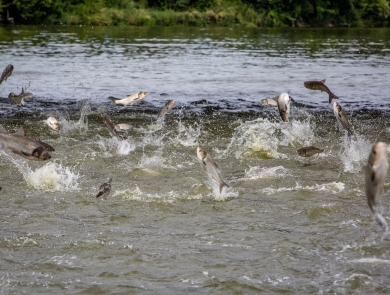About Us
It is the mission of the Columbia River Fish and Wildlife Conservation Office (CRFWCO) to assist in determining the status of imperiled natural stocks, to evaluate management measures for recovery and assist in the recovery of these stocks, and to prevent future listings
What We Do
Our staff collaborates with local, state and Tribal partners to conserve, restore, and improve native fish and aquatic resources throughout Oregon and along the Columbia River and all of its tributaries downstream from McNary Dam to the Pacific Ocean. We study wild and hatchery aquatic organisms and their populations, support habitat restoration, and evaluate restoration projects, fish hatchery practices and human impacts. The results of our studies allow land and natural resource managers to make science informed management decisions.
Our Organization
The CRFWCO provides science-based recommendations for the management of aquatic resources on Federal and Tribal lands in the Pacific Northwest. The programs in our office provide technical assessment, interagency coordination, and representation for technical- and policy-level workgroups, committees, councils, and commissions. Our programs are:
Our Species
Our work focuses on native fish and aquatic species, including those of Tribal importance and species listed under the Endangered Species Act.
Bull Trout
Salvelinus confluentus
Pacific Lamprey
Entosphenus tridentatus
Freshwater Mussels
Western Pearlshell (Margaritifera falcata) Yukon Floater (Anodonta beringiana) Western Ridged Mussel (Gonidea angulata)
Coastal Cutthroat Trout
Oncorhynchus clarkii
Pacific Salmon (Oncorhynchus sp.)
Chinook (O. tshawytscha) Coho (O. kisutch) Chum (O. keta) Pink (O. gorbuscha) Kokanee (O. nerka)
Steelhead
Aquatic Invasive Species
Projects and Research
The Columbia River Fish and Wildlife Conservation Office (CRFWCO) coordinates, facilitates, and implements management actions to conserve and restore fish and aquatic species in the Columbia River Basin and adjacent parts of Oregon, including threatened and endangered resident species, anadromous salmonids, and their associated habitats. Our main conservation and restoration activities include: endangered species review and assessment, fish passage fish passage
Fish passage is the ability of fish or other aquatic species to move freely throughout their life to find food, reproduce, and complete their natural migration cycles. Millions of barriers to fish passage across the country are fragmenting habitat and leading to species declines. The U.S. Fish and Wildlife Service's National Fish Passage Program is working to reconnect watersheds to benefit both wildlife and people.
Learn more about fish passage improvement, tagging and marking of anadromous salmonids, Federal hatchery evaluation, harvest management, aquatic invasive species invasive species
An invasive species is any plant or animal that has spread or been introduced into a new area where they are, or could, cause harm to the environment, economy, or human, animal, or plant health. Their unwelcome presence can destroy ecosystems and cost millions of dollars.
Learn more about invasive species monitoring, and various technical assistance programs. We work through collaboration and partnership with other Federal agencies, stakeholder groups, State and Tribal governments, non-governmental organizations, and the public.
Our geographic focus includes the Columbia River and tributaries downstream from McNary Dam to the Pacific Ocean, and the rest of Oregon (except for the Klamath Basin). Providing technical assistance, interagency coordination, and representation on technical and policy level workgroups, committees, councils, and commissions for hydrosystem, hatchery, harvest, and habitat management are the key tasks for the CRFWCO. The CRFWCO work is guided by, and consistent with, the Pacific Region Fisheries Strategic Plan, USFWS National Fisheries Strategic Plan, and Department of Interior Secretarial priorities.
Get Involved
From invasive species invasive species
An invasive species is any plant or animal that has spread or been introduced into a new area where they are, or could, cause harm to the environment, economy, or human, animal, or plant health. Their unwelcome presence can destroy ecosystems and cost millions of dollars.
Learn more about invasive species removal to protecting endangered species, find out what kind of projects and initiatives we're conducting to protect our aquatic resources.







